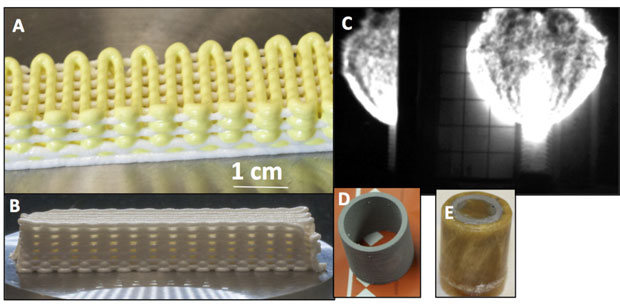Alexander Gash (16-ERD-040)
Project Description
The most important property of high explosives is the ability to detonate. Detonation waves are well known to propagate in a highly repeatable fashion, converting chemical energy into usable mechanical and thermal energy. Currently, modern high-explosives development focuses on designing and synthesizing new molecules with improved performance or energy density. However, the cycle from discovery to application can take many years because of a variety of constraints such as safety, scaling, and cost. It is imperative that we seek alternate routes for improving the safety and performance of our current high-explosives materials to keep pace with the ever-changing and rapidly advancing threats to our national security. There have been significant advancements in manufacturing materials such that it is now feasible to engineer the microscopic structure, or architecture, of a high-explosives part. It is now possible to spatially distribute two or more materials within a three-dimensional object and place them with submillimeter to micron-scale spatial resolution. Because the size and orientation of these features can now be placed on a length scale commensurate with the scale of governing dynamic phenomena, we hypothesize that this opens up new possibilities for modulating the safety and performance of high-explosives systems through architectural design. We therefore plan to simultaneously develop novel fabrication techniques and use dynamic characterization and modeling to capture the unique behavior associated with microscopically designed high-explosive materials. Through characterization and modeling of these novel material structures, we intend to understand, quantify, and model the fundamental effects of high-explosives micro-structural architecture on dynamic response, including both intrinsic and extrinsic phenomena. Specifically, how and to what extent does the architectural length translate into dynamic features as a detonation wave passes (intrinsic effects), and can the architecture be used to focus or defocus the transport of particles via complex interactions during the dynamic event (extrinsic effects). We will examine whether modeling can be used to inform the experimental designs, and what advancements in multiple-scale modeling are required to improve accuracy.
We plan to conduct dynamic imaging experiments to validate and improve simulations of high-explosives detonation. For the first time, we will explore the critical importance of the location, geometry, composition, and interfacial contact between materials in highly engineered high-explosives articles. The spatial resolution of this contact architecture has been limited by traditional processing methods, and therefore has been relatively coarse in current application components. With the successful application of layer-by-layer additive manufacturing of high explosives at Livermore, there now exists the promising opportunity to shrink the high-explosives architectural scale by up to two orders of magnitude. The goal of our effort is to understand the fundamental role that micro-architecture has on the dynamic characteristics of high explosives. This requires a comprehensive and coordinated research program, which will include state-of-the-art additive manufacturing, dynamic diagnostic techniques, and high-explosives modeling. Furthermore, we will examine modulations in the composition of the high-explosives micro-structure at several length scales with the goal of understanding the parameter scaling between such features, and intrinsic detonation properties such as overall detonation velocity and wave shape. We expect our research effort will contribute to the first-principles understanding of energetic materials and in particular, insensitive high explosives, and enable innovative concepts for surety for stockpile modernization. In addition, it will provide novel energetic material solutions to issues relevant to conventional defense, and enable novel materials and understanding of performance–structure relationships.
Mission Relevance
A detailed understanding of new material architectures for high explosives will enable innovative component design to enhance the performance, safety, and precision of the nation's nuclear and conventional stockpiles, as well as address other national security missions. This effort, therefore, is well aligned with the priorities of the Laboratory's strategic focus area in stockpile stewardship science, as well as the core competency in advanced materials and manufacturing.
FY16 Accomplishments and Results
In FY16 we (1) successfully designed and fabricated three-dimensional printed structures of the inert metals aluminum and tungsten, with submillimeter feature resolution; (2) fabricated high explosives and inert composite structures using these inert parts and applied the method of high-explosives melt infiltration into the inert scaffold (this procedure is robust, applicable to any number of different material combinations, and yields composites with high densities); (3) successfully installed an automated mixing system on the direct-ink-write apparatus, enabling it to fabricate single high-explosives components of varying composition; and (4) modeled the mesoscale wave dynamics of a high-explosives and granular metal micro-architecture, with the model indicating behavior variation with initiation type.
Publications and Presentations
- Gash, A., et al., 2016. Printing of high explosive structures using direct ink write methods. Joint Army–Navy–NASA–Air Force 39th Propellant and Explosives Development and Characterization Mtg., Salt Lake City, UT, Dec. 7–10, 2015. LLNL-CONF-679751.
- Sullivan, K. T., et al., Modulating detonation profiles using 3D printed inert scaffolds. Joint Army–Navy–NASA–Air Force 39th Propellant and Explosives Development and Characterization Mtg., Salt Lake City, UT, Dec. 7–10, 2015. LLNL-CONF-679860.
- White, B. W., Sullivan, K. T., and Gash, A. E., Modeling of two-component systems and wave shaping in architected materials. Joint Army–Navy–NASA–Air Force 39th Propellant and Explosives Development and Characterization Mtg., Salt Lake City, UT, Dec. 7–10, 2015. LLNL-PROC-679565.
- White, B. W., et al., Modeling the detonation wave dynamics in reactive materials. 19th International Seminar: New Trends in Research of Energetic Materials, Pardubice, Czech Republic, Apr. 20–22, 2016. LLNL-PROC-687018.






